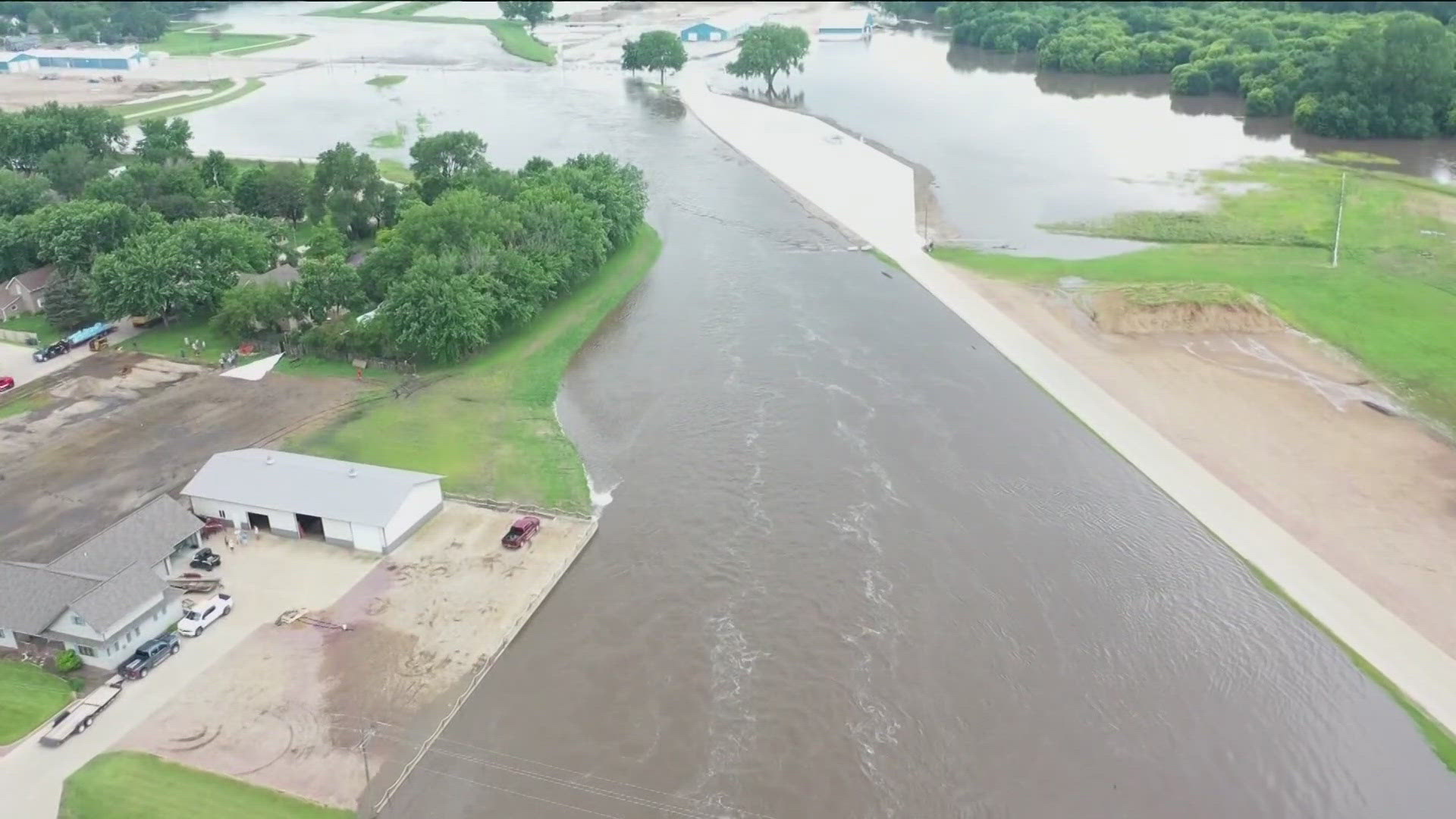SIOUX CITY, Iowa — A railroad bridge collapsed during flooding in the Midwestern U.S. that has forced water rescues, led to evacuations, caused at least one death and brought additional misery during a vast and stubborn heat wave.
The bridge connecting North Sioux City, South Dakota, with Sioux City, Iowa, collapsed into the Big Sioux River late Sunday, an emergency manager said. Local media images showed a large span of the steel bridge partially underwater as floodwaters rushed over it.
South Dakota Gov. Kristi Noem said at a news briefing Monday that the bridge was the main rail link from her state into Iowa. Some of its trusses collapsed, Jason Westcott, an emergency manager in Union County, South Dakota, told KCAU-TV.
There were no reports of injuries from the collapse, which occurred around 11 p.m. The bridge's owner, BNSF Railway, had stopped operating it as a precaution during the flooding, spokesperson Kendall Sloan said. Trains are being rerouted.
“We have damaged roads. We have damaged bridges,” Noem said. “That will impact us for many, many months to come.”
The South Dakota Department of Transportation built a berm Sunday night across Interstate 29 in North Sioux City, temporarily blocking it.
Floodwaters have risen over days of heavy rain where South Dakota, Iowa and Nebraska meet around Sioux City, as well as along the Iowa-Minnesota border. More rain is forecast, and many streams may not crest until later this week as the floodwaters slowly drain to the Missouri and Mississippi rivers.
In Spencer in northwestern Iowa, Aiden Engelkes still wasn't able Monday to get back into his apartment on the first floor of a building close to the Des Moines River, nor could he go to work at a flooded chicken hatchery.
He spent more than seven hours Saturday in a friend's apartment on the fourth floor, waiting to be rescued by a boat, his 2013 Chevy SUV under roiling waters except for a bit of its antenna. Rescuers broke a window in a stairwell on the second floor, and almost 70 people crawled out, volunteers ferrying them away by boat in fours and fives.
Engelkes and his girlfriend left with a bag of clothes, three cats in a carrier, and a kitten his girlfriend carried in her shirt. They expect their apartment to be ruined by about 4 feet of water but hope to still reclaim electronics they placed higher. They're now staying with his mother on higher ground.
“I just keep thinking about all this stuff I’ve lost and maybe the little things I could recover that we put up high,” he said. “And then I think about where my friends are, because their stuff is also gone.”
About 65 miles (105 kilometers) to the west in Rock Valley, Deb Kempema lost her home decor store, First Impressions, after a river levee broke, forcing evacuations and destroying shops.
It was “7,000 square feet of very pretty, pretty things. And it’s all gone," she told KELO-TV. “But I like to reinvent myself, so we’re going to come back better."
The Big Sioux River stabilized Monday morning at around 45 feet, over 7 feet higher than the previous record, Sioux City Fire Marshal Mark Aesoph said. Evacuations have begun for homes at low elevations, and more are expected as waters rise.
Thirteen rivers flooded in that part of Iowa, said Eric Tigges of Clay County emergency management. Entire neighborhoods, and at least one whole town, were evacuated, and Spencer imposed a curfew Sunday for a second night after flooding that surpassed a record set in 1953.
National Guard troops helped with water rescues and carted needed medications lost in flooding.
“Businesses are shuttered. Main streets have been impacted,” Iowa Gov. Kim Reynolds said. “Hospitals, nursing homes and other care facilities were evacuated. Cities are without power, and some are without drinkable water.”
Parts of Nebraska, South Dakota, Minnesota and Iowa received eight times the typical average rainfall, said National Weather Service meteorologist Donna Dubberke.
Elsewhere, the heat remained the biggest worry, even as temperatures moderated at the start of the week in the Northeast and some other parts of the U.S. that have sweltered for days.
Public officials cautioned residents about the dangers of excessive heat and humidity. Forecasters said the heat wave will continue early in the week in the Southeast, portions of the South and the Plains.
Washington, D.C., Baltimore and Philadelphia all saw record heat on over the weekend.
Last year, the U.S. experienced the most heat waves since 1936, experts said. An AP analysis of data from the Centers for Disease Control and Prevention found that excessive heat contributed to more than 2,300 deaths, the highest in 45 years of records.
Watch more Breaking The News:
Watch all of the latest stories from Breaking The News in our YouTube playlist:
WATCH MORE ON KARE 11+
Download the free KARE 11+ app for Roku, Fire TV, Apple TV and other smart TV platforms to watch more from KARE 11 anytime! The KARE 11+ app includes live streams of all of KARE 11's newscasts. You'll also find on-demand replays of newscasts; the latest from KARE 11 Investigates, Breaking the News and the Land of 10,000 Stories; exclusive programs like Verify and HeartThreads; and Minnesota sports talk from our partners at Locked On Minnesota.
- Add KARE 11+ on Roku here or by searching for KARE 11 in the Roku Channel Store.
- Add KARE 11+ on Fire TV here or by searching for KARE 11 in the Amazon App Store.
- Learn more about the KARE 11+ app for Apple TV in the Apple App Store.
- Learn more about KARE 11+ here.

